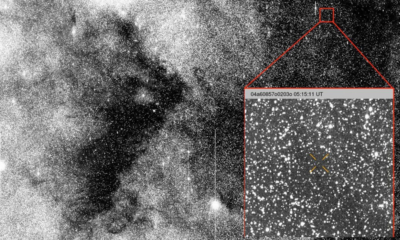Science
New CERN Experiments Illuminate Mystery of Blazar Gamma Rays

Recent experiments conducted at the European Organization for Nuclear Research (CERN) have advanced our understanding of blazars and the puzzling absence of gamma rays associated with these cosmic phenomena. An international team, led by Charles Arrowsmith from the University of Oxford, has ruled out intergalactic magnetic fields as a potential source for this missing radiation, prompting new theories about the early universe’s conditions.
Blazars are among the brightest objects in the universe, characterized by a supermassive black hole at their core. These black holes generate intense beams of radiation as matter is drawn in and expelled in opposing jets. When a blazar is oriented towards Earth, it emits a range of radiation, including terahertz gamma rays. These gamma rays travel through intergalactic space, where they occasionally collide with background starlight. Such interactions can produce cascades of electrons and positrons, leading to the creation of additional gamma rays in the gigaelectronvolt energy range. Surprisingly, this secondary radiation has never been detected.
The team hypothesized that intergalactic magnetic fields could be responsible for the absence of these gamma rays. As Arrowsmith noted, “The electrons and positrons in the pair cascade would be deflected by an intergalactic magnetic field. If this is strong enough, we could expect these pairs to be steered away from the line of sight to the blazar, along with the reprocessed gigaelectronvolt gamma rays.” Despite this explanation, the existence of such magnetic fields remains uncertain, raising questions about their origins.
Another potential explanation for the missing gamma rays involves the sparse plasma that fills intergalactic space. In this scenario, electron-positron pairs could interact with the plasma, generating magnetic fields that separate the pairs. Over millions of years, this interaction might lead to beam-plasma instabilities that diminish the beam’s capability to produce detectable gamma rays.
To further investigate these theories, the team established an experimental platform at the HiRadMat facility at CERN. Here, they created electron-positron pairs and transported them through a one-meter-long argon plasma, simulating the conditions of pair cascades from blazars interacting with the intergalactic medium. After passing through the plasma, the researchers measured the degree of separation of the electron-positron pairs.
The results from the experiment, named Fireball, indicated that the beams remained significantly more focused than anticipated. Arrowsmith explained, “When these laboratory results are scaled up to the astrophysical system, they confirm that beam-plasma instabilities are not strong enough to explain the absence of the gigaelectronvolt gamma rays from blazars.” This suggests that unless the pair beam is perfectly collimated or consists of pairs with exactly equal energies, the instabilities have been effectively suppressed in the plasma.
While these findings indicate that intergalactic magnetic fields may still provide the best explanation for the missing gamma rays, the underlying mystery persists. Gianluca Gregori from the University of Oxford elaborated, “The early universe is believed to be extremely uniform – but magnetic fields require electric currents, which in turn need gradients and inhomogeneities in the primordial plasma.” Confirming the existence of such a field could indicate new physics beyond the Standard Model, which has been dominant in our understanding of the universe.
Future developments may arise from the opening of the Cherenkov Telescope Array Observatory. This facility, with ground-based gamma-ray detectors planned across Spain and Chile, aims to significantly enhance the resolution of current-generation detectors, potentially shedding light on these cosmic mysteries.
The research findings are detailed in a publication in PNAS, adding to the ongoing discourse in astrophysics regarding the enigmatic nature of blazars and the universe’s early conditions.
-

 World2 weeks ago
World2 weeks agoCoronation Street’s Shocking Murder Twist Reveals Family Secrets
-

 Entertainment1 week ago
Entertainment1 week agoAndrew Pierce Confirms Departure from ITV’s Good Morning Britain
-

 Entertainment5 months ago
Entertainment5 months agoKate Garraway Sells £2 Million Home Amid Financial Struggles
-

 Entertainment4 months ago
Entertainment4 months agoAnn Ming Reflects on ITV’s ‘I Fought the Law’ Drama
-

 Entertainment1 month ago
Entertainment1 month agoCoronation Street Fans React as Todd Faces Heartbreaking Choice
-

 Health4 months ago
Health4 months agoKatie Price Faces New Health Concerns After Cancer Symptoms Resurface
-

 World1 month ago
World1 month agoBailey Announces Heartbreaking Split from Rebecca After Reunion
-

 Entertainment2 weeks ago
Entertainment2 weeks agoTwo Stars Evicted from I’m A Celebrity Just Days Before Finale
-

 Entertainment4 months ago
Entertainment4 months agoCoronation Street’s Carl Webster Faces Trouble with New Affairs
-

 World2 weeks ago
World2 weeks agoKevin Sinfield Exceeds Fundraising Goal Ahead of Final Marathons
-

 Entertainment4 months ago
Entertainment4 months agoWhere is Tinder Swindler Simon Leviev? Latest Updates Revealed
-

 Entertainment5 months ago
Entertainment5 months agoMarkiplier Addresses AI Controversy During Livestream Response




















